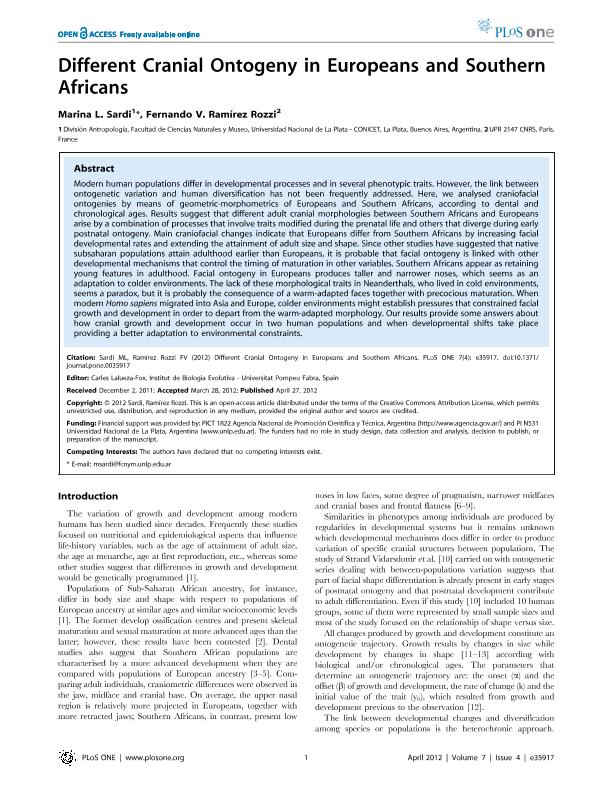Artículo
Different Cranial Ontogeny in Europeans and Southern Africans
Fecha de publicación:
04/2012
Editorial:
Public Library of Science
Revista:
Plos One
ISSN:
1932-6203
Idioma:
Inglés
Tipo de recurso:
Artículo publicado
Clasificación temática:
Resumen
Modern human populations differ in developmental processes and in several phenotypic traits. However, the link between ontogenetic variation and human diversification has not been frequently addressed. Here, we analysed craniofacial ontogenies by means of geometric-morphometrics of Europeans and Southern Africans, according to dental and chronological ages. Results suggest that different adult cranial morphologies between Southern Africans and Europeans arise by a combination of processes that involve traits modified during the prenatal life and others that diverge during early postnatal ontogeny. Main craniofacial changes indicate that Europeans differ from Southern Africans by increasing facial developmental rates and extending the attainment of adult size and shape. Since other studies have suggested that native subsaharan populations attain adulthood earlier than Europeans, it is probable that facial ontogeny is linked with other developmental mechanisms that control the timing of maturation in other variables. Southern Africans appear as retaining young features in adulthood. Facial ontogeny in Europeans produces taller and narrower noses, which seems as an adaptation to colder environments. The lack of these morphological traits in Neanderthals, who lived in cold environments, seems a paradox, but it is probably the consequence of a warm-adapted faces together with precocious maturation. When modern Homo sapiens migrated into Asia and Europe, colder environments might establish pressures that constrained facial growth and development in order to depart from the warm-adapted morphology. Our results provide some answers about how cranial growth and development occur in two human populations and when developmental shifts take place providing a better adaptation to environmental constraints.
Palabras clave:
Development
,
Heterochrony
,
Adaptation
Archivos asociados
Licencia
Identificadores
Colecciones
Articulos(CCT - LA PLATA)
Articulos de CTRO.CIENTIFICO TECNOL.CONICET - LA PLATA
Articulos de CTRO.CIENTIFICO TECNOL.CONICET - LA PLATA
Citación
Sardi, Marina Laura; Ramírez Rozzi, Fernando V.; Different Cranial Ontogeny in Europeans and Southern Africans; Public Library of Science; Plos One; 7; 4; 4-2012; 1-12
Compartir
Altmétricas




